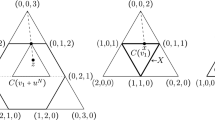Abstract
This paper presents two characterizations of the core on the domain of all NTU games. One is based on consistency with respect to “complement-reduced game” and converse consistency with respect to “max-reduced game”. The other is based on consistency with respect to “max-reduced game” and weak converse consistency with respect to “complement-reduced game”. Besides, we introduce an alternative definition of individual rationality, we name conditional individual rationality, which is compatible with non-emptiness. We discuss axiomatic characterizations involving conditional individual rationality for the core.
Similar content being viewed by others
Notes
We follow the terminology of Thomson (1995).
Of course, it is redundant on the domain of games with a nonempty core.
For \(A\subseteq I\!\!R^S\), we say that x is an interior point of A if there is a \(y \in A\) such that \(y \gg x\). But, under the assumption of the non-levelness condition, the strict notion “\(\gg \)” can be replaced by the weak notion of a blocking coalition “\(>\)”. That is, x is an interior point of A if there is a \(y \in A\) such that \(y > x\). In Definition 2, we state that x is in the core of \((N,V)\) if \(x^S\) is not an interior point of \(V(S)\) for all \(S\subseteq N\). Therefore, under the assumption of the non-levelness condition, the weak notion of a blocking coalition (“\(>\)”) can be adopted instead. Here, we prefer the strict notion “\(\gg \)” because it is commonly used to define the core in the literature.
I acknowledge that it was the AE who suggested CIR and raised the questions about its implications.
For the definitions of the prenucleolus and the nucleolus of a game, see Orshan and Sudhölter (2010).
For the definition of the kernel of a game, see Davis and Maschler (1965).
References
Aumann RJ, Dréze J (1974) Cooperative games with coalition structures. Int J Game Theory 3:217–237
Bejan C, Gómez JC (2009) Core extensions for non-balanced TU games. Int J Game Theory 38:3–16
Davis M, Maschler M (1965) The kernel of a cooperative game. Nav Res Logist Q 12:223–259
Greenberg J (1985) Cores of convex games without side payments. Math Oper Res 10:523–525
Harsanyi JC (1959) A bargaining model for the cooperative n-person games. In: Tucker AW, Luce RD (eds) Contributions to the theory of games IV. Princeton University Press, Princeton , pp 325–355
Hart S (1985) An axiomatization of Harsanyi’s nontransferable utility solution. Econometrica 53:1295–1313
Hart S, Mas-Colell A (1989) Potential, value, and consistency. Econometrica 57:589–614
Hwang YA, Sudhölter P (2001) Axiomatizations of the core on the universal domain and other natural domains. Int J Game Theory 29:597–623
Imai H (1983) Individual monotonicity and lexicographic maximin solutions. Econometrica 51:389–401
Moulin H (1985) The separability axiom and equal sharing methods. J Econ Theory 36:120–148
Nash J (1950) The bargaining problem. Econometrica 18:155–162
Orshan G, Sudhölter P (2010) The positive core of a cooperative game. Int J Game Theory 39:113–136
Peleg B (1985) An axiomatization of the core of cooperative games without side payments. J Math Econ 14:203–214
Peleg B (1986) On the reduced game property and its converse. Int J Game Theory 15:187–200
Roth AE (1977) Independence of irrelevant alternatives and solutions to Nash’s bargaining problem. J Econ Theory 16:247–251
Serrano R, Volij O (1998) Axiomatizations of neoclassical concepts for economies. J Math Econ 30:87–108
Sobolev AI (1975) The characterization of optimality principles in cooperative games by functional equations. In: Vorobiev NN (ed) Mathematical methods in the social sciences, vol 6. Academy of Sciences of the Lithuanian SSR, Vilnius, pp 95–151 (in Russian)
Tadenuma K (1992) Reduced games, consistency, and the core. Int J Game Theory 20:325–334
Thomson W (1995) Consistent allocation rules. University of Rochester, Mimeo
Acknowledgments
The author is very grateful to the AE and anonymous referees for valuable comments which much improved the paper.
Author information
Authors and Affiliations
Corresponding author
Rights and permissions
About this article
Cite this article
Hwang, YA. On the core: complement-reduced game and max-reduced game. Int J Game Theory 42, 339–355 (2013). https://doi.org/10.1007/s00182-013-0372-z
Accepted:
Published:
Issue Date:
DOI: https://doi.org/10.1007/s00182-013-0372-z



